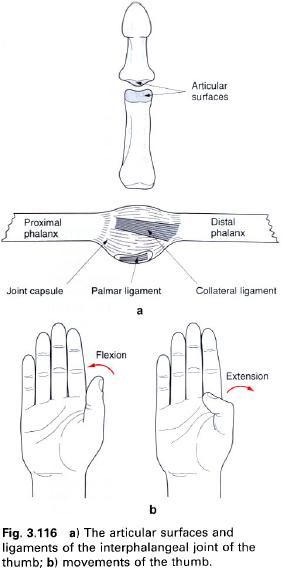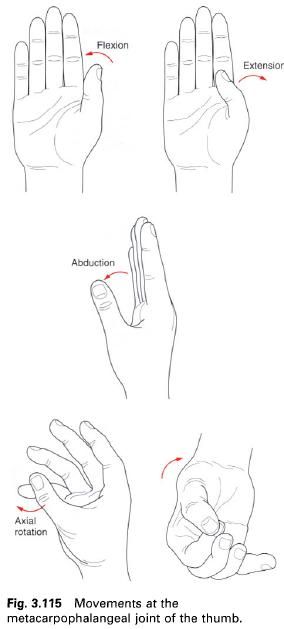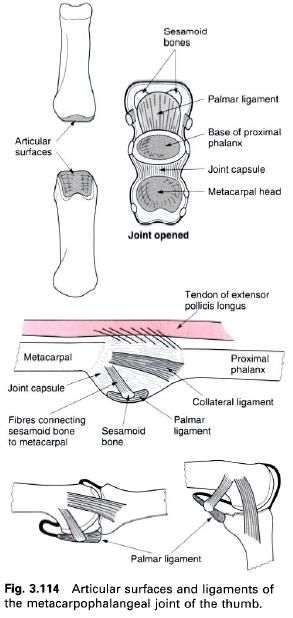Metacarpophalangeal joint
The metacarpophalangeal joint of the thumb is
of similar design to those of the fingers, being a synovial condyloid joint
between the head of the first metacarpal and the base of the proximal phalanx.
Articular
surfaces
The articulation is between the rounded head of
the metacarpal and the shallow, oval concavity of the base of the proximal
phalanx(picture below). Both surfaces are covered with hyaline cartilage. The
biconvex metacarpal head is wider anteriorly than posteriorly; indeed the
articular surface does not extend very far on its posterior surface. In
addition, the curvature of the metacarpal head is greater in the transverse
plane than in the anteroposterior plane. The base of the proximal phalanx has a
much smaller articular area than the metacarpal head. It is increased
anteriorly however, by the presence of a fibrocartilaginous plate known as the
palmaer ligament, which is attached to the anterior surface of the base of the
phalanx by a small fibrous band which functions like a hinge.
Joint
capsule and synovial membrane
A loose fibrous capsule surrounds the joint,
being attached closer to the articular margins posteriorly than
anteriorly(picture above). It is strengthened at the sides by collateral
ligaments. Anteriorly the capsule is mainly replaced by the palmar ligament,
which has a weak attachment to the neck of the metacarpal. Posteriorly the
capsule is strengthened by or may be entirely replaced by the expansion of extensor pollicis longus.
Synovial membrane lines all non-articular
surfaces of the joint and presents anterior and posterior recesses when the
joint is extended.
Ligaments
The palmar ligament is a dense
fibrocartilaginous pad that increases the phalangeal articular surface
anteriorly. It is firmly attached to the anterior surface of the base of the
proximal phalanx, and loosely attached to the anterior aspect of the neck of
the metacarpal(picture above). The collateral ligaments of the joint blend with
the sides of the palmar ligament. The ligament contains two small sesamoid
bones which are attached to the phalanx and the metacarpal by straight and
cruciate fibres. It is grooved on its anterior aspect by the tendon of flexor pollicis longus.
The strong collateral ligaments on either side
of the joint are attached proximally to the tubercle and adjacent depression on
the side of the metacarpal head, and pass to the palmar aspect of the neck of
the metacarpal(picture above). Although cord-like in appearance, they do fan
out slightly from proximal to distal gaining attachment to the margins of the
palmar ligament. The collateral ligaments are relatively lax during extension,
becoming increasingly taut with flexion of the joint.
Blood
and nerve supply
The arterial supply to the joint is by branches
from the princes pollicis artery,
while its nerve supply is by twigs from the median
nerve, root value C7.
Stability
The metacarpophalangeal joint of the thumb is
stabilized by the collateral ligaments, as well as the tendons of flexor and extensor pollicis longus as they pass in front of and behind the
joint to their insertion on the distal phalanx. Flexor and extensor pollicis brevis and abductor pollicis brevis
also cross the joint to insert into the base of the proximal phalanx.
Movements
Being a condyloid joint, the
metacarpophalangeal joint has, according to its shape, two degrees of freedom
of movement, these being flexion and extension, abduction and adduction.
However, as in the carpometacarpal joint, there is a third movement of axial
rotation which occurs passively and is allowed because of a small degree of
elasticity of the associated ligaments.
Flexion
and extension. At the
metacarpophalangeal joint this occurs about a single, fixed axis which passes
transversely through the metacarpal at approximately nine-tenths of its midline
length from its base. In passing from flexion to extension, the area of contact
shifts from the palmar end of the phalangeal base to its distal end.
Flexion has a range of 45°, while extension is
zero under normal circumstances, both actively and passively(picture above). It
is in full extension that the anterior part of the metacarpal head articulates
with the palmar ligament. As flexion proceeds, the palmar ligament gradually
loses contact with the metacarpal head. At the same time the synovial recesses
progressively become unpleated.
Flexion at the joint is brought about primarily
by flexor pollicis brevis, aided by flexor pollicis longus. Similarly,
extension from the flexed position is due primarily to extensor pollicis brevis, with some help from extensor pollicis longus.
Abduction
and adduction. These are
limited due to the width of the metacarpal head(picture above). The 15° of
abduction and negligible adduction occurs about an anteroposterior axis through
the head of the metacarpal. As well as the bony limitations to the movements,
the collateral ligaments also become taut adding to the restriction.
Abduction is caused by contraction of abductor pollicis brevis. Although adductor pollicis attaches to the base
of proximal phalanx, because of the severe limitation of adduction at the
metacarpophalangeal joint, its action is seen principally at the
carpometacarpal joint.
A certain amount of axial rotation is possible
at the metacarpophalangeal joint of the thumb, which is of importance during
opposition(picture above). The movement can be produced actively by the
co-contraction of flexor and abductor pollicis brevis, or passively
as when pressing the thumb against the index finger. The actively produced
rotation is always medially directed, while that produced passively can be in
either direction depending which side of the thumb comes into contact with the
finger.
Movements
at the joint during opposition.
These include a secondary flexion at the metacarpophalangeal joint following
that at the carpometacarpal joint during opposition. At the same time there is
abduction at the joint, which continues after the metacarpal becomes adducted.
The degree of abduction is largest when contact is made with the pad of the
little finger. The flexion and abduction movements at the metacarpophalangeal
joint cause, initially, an active axial rotation at the joint. After contact
has been made the degree of rotation may be augmented passively.
Interphalangeal joint
Because the thumb only contains two phalanges,
there is only one interphalangeal joint. Like those of the fingers, however, it
is a synovial hinge joint permitting movement in one direction only.
Articular
surfaces
The articulation is between the pulley-shaped
head of the proximal phalanx and the base of the distal phalanx which has a
median ridge separating two shallow facets(figure a below). As in the
metacarpophalangeal joint, a fibrocartilaginous plate(palmar ligament) is
attached to the anterior margin of the base of the distal phalanx.
Joint
capsule and synovial membrane
A fibrous capsule completely surrounds the
joint, being replaced by the palmar ligament anteriorly and strengthened at the
sides by the collateral ligaments(figure a).
Ligaments
The collateral ligaments are attached to the
sides of the head of the proximal phalanx, and pass to the palmar aspect of the
base of the distal phalanx. They blend with the lateral margins of the palmar
ligament.
As in the metacarpophalangeal joint, the palmar
ligament is a fibrocartilaginous plate attached to the anterior margin of the
base of the distal phalanx. It is loosely attached to the front of the neck of
the proximal phalanx via the joint capsule.
Blood
and nerve supply
The blood and nerve supply is the same as that
for the metacarpophalangeal joint.
Movements
Being a hinge joint supported by strong
collateral ligaments, movement is only allowed in one plane(figure b). Flexion
and extension occur about a transverse axis passing approximately through the
neck of the proximal phalanx. The range of flexion is in excess of 90°, while
extension is normally no more than 10°. However, passive hyperextension may be
marked in some individuals who apply large forces using the thumb, for example
butchers and physiotherapy manipulators.
Accessory movements of joints of the thumb
Carpometacarpal
joint. Gripping the trapezium
between the thumb and the index finger of one hand, and the base of the first
metacarpal with the other, the metacarpal base can be moved in both
anteroposterior and mediolateral directions. With the same grip longitudinal
gapping and rotation can be achieved.
Metacarpophalangeal
and interphalangeal joints. If
the principle of stabilizing the proximal bone and moving the distal one is
employed, then anteroposterior gliding movements can be demonstrated at both
the metacarpophalangeal and interphalangeal joints. Once again, best results
are obtained when each bone is held firmly between the thumb and index finger.
A good range of rotation, as well as longitudinal gapping, is also possible at
the metacarpophalangeal joint.












0 коментара:
Постави коментар